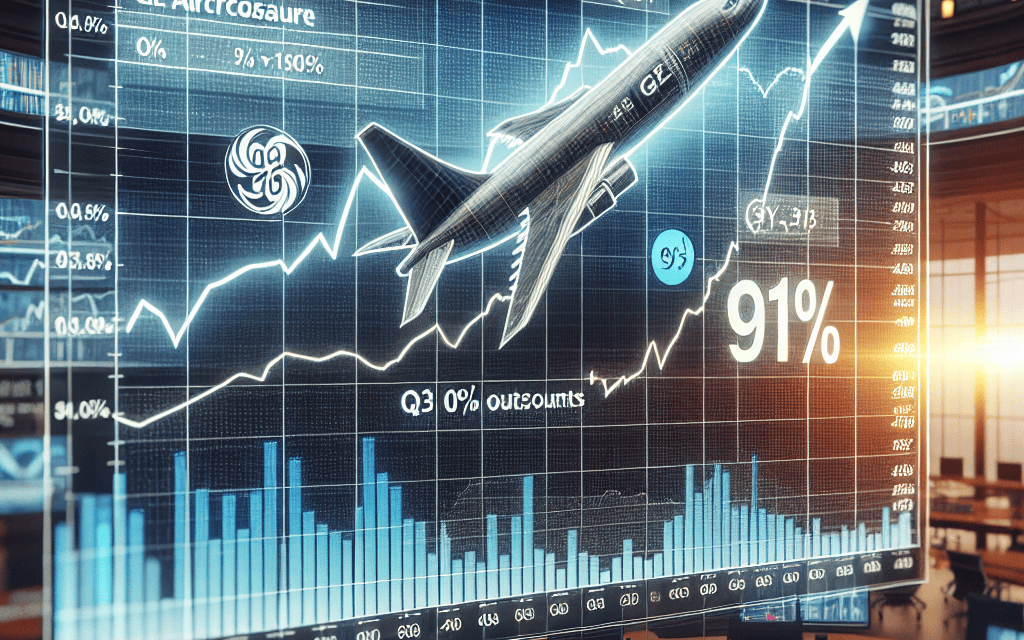“GE Aerospace: Navigating New Heights with Strategic Precision Amidst Q3 Challenges”
Introduction
GE Aerospace, a leading player in the aviation industry, is navigating a pivotal moment as it prepares to adjust following a remarkable 91% gain, despite facing mixed outcomes in its third-quarter performance. The company, renowned for its innovative aerospace solutions and robust market presence, has demonstrated significant growth, reflecting its strategic initiatives and operational efficiencies. However, the recent quarterly results present a complex picture, with certain challenges tempering the overall positive trajectory. As GE Aerospace strategizes to sustain its upward momentum, stakeholders are keenly observing how the company will address these mixed signals and leverage its strengths to maintain its competitive edge in the dynamic aerospace sector.
Understanding GE Aerospace’s Q3 Performance: A Detailed Analysis
General Electric’s aerospace division, GE Aerospace, has recently captured the attention of investors and industry analysts alike, following a remarkable 91% gain in its stock value. This surge, however, comes amid a backdrop of mixed third-quarter outcomes, prompting a closer examination of the factors contributing to its performance. As we delve into the intricacies of GE Aerospace’s Q3 results, it becomes evident that a combination of strategic initiatives, market dynamics, and operational challenges have played pivotal roles in shaping the company’s trajectory.
To begin with, GE Aerospace’s impressive stock performance can be attributed to its robust revenue growth, driven primarily by a resurgence in the aviation sector. As global air travel continues to recover from the pandemic-induced downturn, demand for aircraft engines and related services has surged. GE Aerospace, being a key player in this domain, has capitalized on this trend by securing significant contracts with major airlines and aircraft manufacturers. This uptick in demand has not only bolstered the company’s top line but has also instilled confidence among investors regarding its long-term growth prospects.
Moreover, GE Aerospace’s strategic focus on innovation and sustainability has further enhanced its competitive edge. The company has been at the forefront of developing next-generation engine technologies that promise to reduce fuel consumption and emissions. By aligning its product offerings with the aviation industry’s increasing emphasis on environmental sustainability, GE Aerospace has positioned itself as a preferred partner for airlines seeking to modernize their fleets. This strategic alignment has not only driven revenue growth but has also reinforced the company’s reputation as a leader in aerospace innovation.
However, despite these positive developments, GE Aerospace’s Q3 performance was not without its challenges. The company faced supply chain disruptions, a lingering issue that has affected many industries globally. These disruptions have led to delays in production and delivery schedules, impacting the company’s ability to meet the burgeoning demand for its products. Additionally, rising raw material costs have exerted pressure on profit margins, posing a challenge to maintaining profitability in the face of increased operational expenses.
In response to these challenges, GE Aerospace has undertaken several measures to mitigate their impact. The company has intensified its efforts to diversify its supplier base, thereby reducing its vulnerability to supply chain bottlenecks. Furthermore, GE Aerospace has implemented cost-control initiatives aimed at optimizing operational efficiency and preserving margins. These proactive steps underscore the company’s commitment to navigating the complexities of the current business environment while safeguarding its financial health.
Looking ahead, GE Aerospace remains poised to adjust its strategies to sustain its growth momentum. The company is expected to continue leveraging its technological prowess and market position to capture emerging opportunities in the aerospace sector. Additionally, ongoing investments in research and development are likely to yield innovative solutions that address the evolving needs of the aviation industry. As GE Aerospace adapts to the dynamic landscape, its ability to balance growth aspirations with operational resilience will be crucial in maintaining investor confidence and achieving sustained success.
In conclusion, GE Aerospace’s Q3 performance reflects a nuanced interplay of growth drivers and operational challenges. While the company has demonstrated remarkable resilience and adaptability, it must continue to navigate the complexities of the global market to sustain its upward trajectory. As the aerospace industry evolves, GE Aerospace’s strategic initiatives and commitment to innovation will be instrumental in shaping its future performance and ensuring its continued prominence in the sector.
Factors Contributing to GE Aerospace’s 91% Gain
General Electric’s aerospace division has recently captured significant attention in the financial world, boasting an impressive 91% gain. This remarkable performance can be attributed to a confluence of factors that have positioned GE Aerospace as a formidable player in the industry. However, the mixed outcomes of the third quarter have introduced a degree of uncertainty, prompting analysts and investors to closely examine the underlying elements that have driven this growth and the potential challenges that lie ahead.
One of the primary factors contributing to GE Aerospace’s substantial gain is the resurgence of the global aviation industry. As the world gradually recovers from the disruptions caused by the COVID-19 pandemic, there has been a notable increase in air travel demand. This resurgence has, in turn, led to a heightened demand for aircraft engines and related services, areas where GE Aerospace has established a strong foothold. The division’s ability to capitalize on this demand surge has been instrumental in driving its impressive financial performance.
Moreover, GE Aerospace’s strategic focus on innovation and technological advancement has played a crucial role in its success. The division has consistently invested in research and development to enhance the efficiency and sustainability of its products. This commitment to innovation has not only strengthened its competitive position but also aligned with the growing industry emphasis on reducing carbon emissions and improving fuel efficiency. By offering cutting-edge solutions that address these critical concerns, GE Aerospace has managed to attract a broad customer base, further bolstering its financial standing.
In addition to these industry-specific factors, GE Aerospace has benefited from the broader corporate restructuring efforts undertaken by its parent company, General Electric. The strategic decision to streamline operations and focus on core business areas has allowed GE Aerospace to operate with greater agility and efficiency. This restructuring has enabled the division to allocate resources more effectively, optimize its supply chain, and enhance its overall operational performance. Consequently, GE Aerospace has been able to deliver strong financial results, contributing significantly to the 91% gain.
However, despite these positive developments, the mixed outcomes of the third quarter have introduced a layer of complexity to GE Aerospace’s growth narrative. While the division has demonstrated resilience and adaptability, it faces several challenges that could impact its future performance. Supply chain disruptions, fluctuating raw material costs, and geopolitical uncertainties are among the factors that could potentially hinder its growth trajectory. Furthermore, the competitive landscape in the aerospace industry remains intense, with rival companies continuously striving to capture market share through innovation and strategic partnerships.
In light of these challenges, GE Aerospace’s ability to sustain its impressive gains will depend on its capacity to navigate these complexities effectively. The division’s continued focus on innovation, operational efficiency, and strategic partnerships will be crucial in maintaining its competitive edge. Additionally, its responsiveness to evolving market dynamics and customer needs will play a pivotal role in shaping its future success.
In conclusion, GE Aerospace’s 91% gain is a testament to its strategic acumen and ability to leverage favorable industry trends. While the mixed outcomes of the third quarter present certain challenges, the division’s strong foundation and commitment to innovation position it well to adapt and thrive in an ever-evolving aerospace landscape. As the industry continues to evolve, GE Aerospace’s strategic initiatives and operational resilience will be key determinants of its sustained growth and success.
Challenges Faced by GE Aerospace in Q3 and Their Impact
In the third quarter of the fiscal year, GE Aerospace experienced a complex landscape of challenges that have impacted its impressive 91% gain. The company, a key player in the aviation industry, has been navigating a series of hurdles that have tested its resilience and strategic acumen. These challenges, while significant, have not entirely overshadowed the company’s achievements but have certainly influenced its trajectory.
One of the primary challenges faced by GE Aerospace in the third quarter was the fluctuating demand in the aviation sector. The industry, still recovering from the pandemic’s aftermath, has seen uneven growth patterns. While domestic travel in several regions has rebounded, international travel remains inconsistent due to varying travel restrictions and health protocols. This inconsistency has led to unpredictable demand for aircraft engines and related services, directly affecting GE Aerospace’s order book and revenue projections.
Moreover, the company has been grappling with supply chain disruptions, a challenge that has plagued many industries globally. The aerospace sector, in particular, relies heavily on a complex network of suppliers for components and materials. Any disruption in this chain can lead to delays in production and delivery schedules. GE Aerospace has had to contend with shortages of critical components, which have, in turn, affected its ability to meet customer demands promptly. These supply chain issues have necessitated a reevaluation of inventory management and supplier relationships to mitigate future risks.
In addition to supply chain challenges, GE Aerospace has faced rising costs of raw materials and labor. Inflationary pressures have increased the cost of production, squeezing profit margins. The company has had to balance these rising costs with the need to remain competitive in pricing, a delicate act that requires strategic pricing models and cost management practices. This financial pressure has been a significant factor in the mixed outcomes observed in the third quarter.
Furthermore, technological advancements and the push for sustainable aviation have presented both opportunities and challenges for GE Aerospace. The industry is moving towards more fuel-efficient and environmentally friendly technologies, and GE Aerospace is at the forefront of this transition. However, the research and development required to innovate in this space demand substantial investment. Balancing these investments with short-term financial performance has been a critical challenge for the company.
Despite these hurdles, GE Aerospace has demonstrated resilience and adaptability. The company’s strategic initiatives, such as diversifying its product offerings and expanding its service capabilities, have helped cushion the impact of these challenges. Additionally, GE Aerospace’s focus on digital transformation and operational efficiency has enabled it to streamline processes and reduce costs, partially offsetting the financial pressures faced during the quarter.
In conclusion, while GE Aerospace’s 91% gain is a testament to its strong market position and strategic initiatives, the mixed outcomes of the third quarter highlight the challenges that continue to shape its path forward. The company must navigate the complexities of fluctuating demand, supply chain disruptions, rising costs, and the push for technological innovation. As GE Aerospace adjusts to these realities, its ability to adapt and innovate will be crucial in maintaining its growth trajectory and achieving long-term success in the ever-evolving aerospace industry.
Strategic Adjustments by GE Aerospace Post-Q3 Results

GE Aerospace, a prominent division of General Electric, has recently experienced a significant 91% gain, reflecting its robust performance and strategic positioning in the aerospace industry. However, the mixed outcomes of the third quarter have prompted the company to consider strategic adjustments to maintain its upward trajectory. As the aerospace sector continues to navigate a complex landscape marked by fluctuating demand and evolving technological advancements, GE Aerospace is poised to recalibrate its strategies to sustain growth and address emerging challenges.
The third quarter results, while showcasing impressive gains, also highlighted areas that require attention. On one hand, the division benefited from a resurgence in air travel, which has driven demand for aircraft engines and related services. This uptick in travel has been a boon for GE Aerospace, as airlines seek to modernize their fleets and enhance fuel efficiency. Consequently, the division’s revenue from commercial engines and services has seen a notable increase, contributing significantly to the overall 91% gain.
On the other hand, the quarter also revealed certain headwinds that could impact future performance. Supply chain disruptions, a persistent issue across various industries, have posed challenges for GE Aerospace. These disruptions have led to delays in production and delivery schedules, affecting the division’s ability to meet the growing demand promptly. Additionally, rising raw material costs have exerted pressure on profit margins, necessitating a strategic reassessment to mitigate these impacts.
In response to these mixed outcomes, GE Aerospace is exploring several strategic adjustments. One key area of focus is enhancing supply chain resilience. By diversifying its supplier base and investing in advanced logistics solutions, the division aims to reduce its vulnerability to disruptions and ensure a steady flow of components and materials. This proactive approach is expected to bolster production capabilities and improve delivery timelines, thereby strengthening customer relationships and maintaining competitive advantage.
Moreover, GE Aerospace is intensifying its efforts in research and development to drive innovation and maintain its leadership in the aerospace sector. By investing in cutting-edge technologies, such as sustainable aviation fuels and hybrid-electric propulsion systems, the division seeks to align with the industry’s growing emphasis on sustainability and environmental responsibility. These innovations not only address regulatory pressures but also position GE Aerospace as a forward-thinking player in the market, capable of meeting the evolving needs of its customers.
Furthermore, the division is placing a renewed emphasis on cost management and operational efficiency. By streamlining processes and leveraging digital tools, GE Aerospace aims to optimize its operations and enhance profitability. This strategic focus on efficiency is crucial in offsetting the impact of rising costs and ensuring that the division remains financially robust in the face of external challenges.
In conclusion, while GE Aerospace’s 91% gain underscores its strong performance, the mixed outcomes of the third quarter necessitate strategic adjustments to sustain growth. By addressing supply chain vulnerabilities, investing in innovation, and enhancing operational efficiency, the division is well-positioned to navigate the complexities of the aerospace industry. As it continues to adapt to changing market dynamics, GE Aerospace remains committed to delivering value to its stakeholders and maintaining its status as a leader in the aerospace sector.
Market Reactions to GE Aerospace’s Mixed Q3 Outcomes
General Electric’s aerospace division, GE Aerospace, has recently captured the attention of investors and market analysts alike, following the release of its mixed third-quarter outcomes. The division, which has been a significant contributor to GE’s overall performance, reported a 91% gain, a figure that has sparked both optimism and caution within the financial community. As stakeholders digest these results, the market’s reaction has been characterized by a blend of enthusiasm and prudence, reflecting the complex dynamics at play.
To begin with, the impressive 91% gain underscores GE Aerospace’s robust operational capabilities and its ability to navigate the challenges posed by the global economic landscape. This growth can be attributed to several factors, including a resurgence in air travel demand, which has driven increased orders for aircraft engines and related services. Moreover, GE Aerospace’s strategic focus on innovation and efficiency has enabled it to capitalize on emerging opportunities within the aviation sector. These positive developments have undoubtedly bolstered investor confidence, as evidenced by the initial surge in GE’s stock price following the earnings announcement.
However, it is essential to consider the broader context in which these results were achieved. Despite the substantial gain, GE Aerospace’s third-quarter performance was not without its challenges. The division faced headwinds in the form of supply chain disruptions and rising material costs, which have been pervasive issues across the manufacturing industry. These factors have exerted pressure on profit margins, tempering the overall financial performance. Consequently, while the topline growth is commendable, the mixed nature of the outcomes has prompted a more measured response from the market.
In light of these mixed results, market participants are now closely monitoring GE Aerospace’s strategic initiatives aimed at sustaining its growth trajectory. The division’s commitment to advancing its technological capabilities, particularly in the realm of sustainable aviation, is a key area of focus. By investing in next-generation engine technologies and exploring alternative fuels, GE Aerospace is positioning itself to meet the evolving demands of the aviation industry. This forward-looking approach is expected to enhance the division’s competitive edge and drive long-term value creation.
Furthermore, the market’s reaction to GE Aerospace’s third-quarter outcomes is also influenced by the broader economic environment. With concerns about inflation and geopolitical tensions persisting, investors are exercising caution in their assessment of future growth prospects. The aerospace sector, while resilient, is not immune to these macroeconomic pressures, which could impact demand and profitability in the coming quarters. As such, market participants are weighing the potential risks and rewards associated with GE Aerospace’s performance, leading to a more nuanced evaluation of its stock.
In conclusion, GE Aerospace’s 91% gain in the third quarter represents a significant achievement, reflecting the division’s operational strength and strategic foresight. However, the mixed nature of the outcomes, coupled with external challenges, has resulted in a cautious market response. As GE Aerospace continues to navigate this complex landscape, its ability to adapt and innovate will be crucial in sustaining its growth momentum. Investors and analysts alike will be keenly observing the division’s progress, as it seeks to balance short-term challenges with long-term opportunities in the ever-evolving aerospace industry.
Future Prospects for GE Aerospace After Q3 Adjustments
GE Aerospace, a prominent division of General Electric, has recently captured the attention of investors and industry analysts alike, following a remarkable 91% gain. This impressive performance, however, comes amid a backdrop of mixed outcomes in the third quarter, prompting a closer examination of the company’s future prospects. As the aerospace sector continues to navigate a complex landscape marked by both opportunities and challenges, GE Aerospace’s strategic adjustments will be crucial in sustaining its upward trajectory.
The third quarter results for GE Aerospace revealed a nuanced picture. On one hand, the division benefited from a resurgence in air travel demand, which has been steadily recovering from the pandemic-induced downturn. This resurgence has led to increased orders for aircraft engines and related services, providing a significant boost to the company’s revenue streams. Moreover, GE Aerospace’s commitment to innovation and technological advancement has positioned it favorably in a competitive market, allowing it to capture new business opportunities and expand its customer base.
However, the division also faces several headwinds that could temper its growth prospects. Supply chain disruptions, a lingering issue across various industries, have posed challenges in meeting production schedules and fulfilling orders. These disruptions have led to increased costs and delays, impacting the division’s overall operational efficiency. Additionally, the aerospace sector is grappling with rising fuel prices and environmental concerns, which are prompting airlines to seek more fuel-efficient and sustainable solutions. GE Aerospace must therefore continue to invest in research and development to address these evolving demands and maintain its competitive edge.
In light of these mixed outcomes, GE Aerospace is poised to make strategic adjustments to sustain its growth momentum. One key area of focus is enhancing its supply chain resilience. By diversifying its supplier base and investing in advanced manufacturing technologies, the division aims to mitigate the impact of future disruptions and improve its ability to meet customer demands promptly. Furthermore, GE Aerospace is exploring partnerships and collaborations with other industry players to leverage synergies and drive innovation in sustainable aviation technologies.
Another critical aspect of GE Aerospace’s strategy is its emphasis on digital transformation. By harnessing the power of data analytics and artificial intelligence, the division seeks to optimize its operations, improve product performance, and deliver enhanced value to its customers. This digital shift not only enhances operational efficiency but also enables GE Aerospace to offer predictive maintenance solutions, reducing downtime and operational costs for airlines.
Looking ahead, GE Aerospace’s future prospects will largely depend on its ability to navigate the evolving industry landscape and capitalize on emerging opportunities. The division’s strong foundation, built on a legacy of engineering excellence and innovation, provides a solid platform for future growth. However, it must remain agile and adaptable, continuously refining its strategies to address the dynamic challenges and opportunities that lie ahead.
In conclusion, while GE Aerospace’s 91% gain is a testament to its resilience and strategic acumen, the mixed outcomes of the third quarter underscore the need for careful adjustments. By focusing on supply chain resilience, digital transformation, and sustainable innovation, GE Aerospace is well-positioned to sustain its growth trajectory and continue delivering value to its stakeholders. As the aerospace industry evolves, GE Aerospace’s proactive approach will be instrumental in shaping its future success.
Comparing GE Aerospace’s Q3 Performance with Industry Peers
In the third quarter of 2023, GE Aerospace reported a remarkable 91% gain, a figure that has captured the attention of industry analysts and investors alike. This impressive performance, however, comes amid a backdrop of mixed outcomes within the aerospace sector, prompting a closer examination of how GE Aerospace’s results compare with those of its industry peers. As the aerospace industry continues to navigate a complex landscape marked by fluctuating demand, supply chain disruptions, and evolving technological advancements, GE Aerospace’s performance offers a compelling case study.
To begin with, GE Aerospace’s 91% gain is a testament to its strategic initiatives and operational efficiencies. The company has successfully capitalized on the resurgence in air travel demand, which has been steadily recovering from the pandemic-induced downturn. By focusing on innovation and expanding its product offerings, GE Aerospace has managed to capture a significant share of the market, particularly in the commercial aviation segment. This growth is further bolstered by the company’s robust order book, which reflects strong demand for its next-generation engines and related technologies.
In contrast, some of GE Aerospace’s competitors have faced challenges in achieving similar growth. For instance, while companies like Rolls-Royce and Pratt & Whitney have also benefited from the uptick in air travel, they have encountered hurdles such as supply chain constraints and rising production costs. These issues have, in some cases, tempered their financial performance, highlighting the importance of effective supply chain management and cost control in the current environment. Consequently, GE Aerospace’s ability to navigate these challenges more adeptly than some of its peers underscores its competitive advantage.
Moreover, the mixed outcomes in the aerospace sector can be attributed to varying levels of exposure to different market segments. While GE Aerospace has a strong presence in both commercial and military aviation, other companies may have a more concentrated focus, which can impact their performance. For example, firms with a heavier reliance on defense contracts may experience fluctuations based on government spending patterns and geopolitical developments. In this context, GE Aerospace’s diversified portfolio provides a buffer against such volatility, allowing it to maintain steady growth.
Another factor contributing to GE Aerospace’s standout performance is its commitment to sustainability and innovation. The company has been at the forefront of developing eco-friendly technologies, such as fuel-efficient engines and sustainable aviation fuels. This focus not only aligns with global efforts to reduce carbon emissions but also positions GE Aerospace favorably in an industry increasingly prioritizing environmental considerations. By contrast, peers that have been slower to adopt sustainable practices may find themselves at a competitive disadvantage as regulatory pressures and consumer preferences shift.
In summary, GE Aerospace’s 91% gain in the third quarter of 2023 highlights its strategic acumen and operational resilience in a challenging industry landscape. While the aerospace sector as a whole has experienced mixed outcomes, GE Aerospace’s ability to leverage market opportunities, manage supply chain complexities, and drive innovation has set it apart from its peers. As the industry continues to evolve, GE Aerospace’s performance serves as a benchmark for success, illustrating the critical importance of adaptability and forward-thinking strategies in achieving sustained growth.
Q&A
1. **What is the recent performance of GE Aerospace’s stock?**
GE Aerospace’s stock has recently experienced a 91% gain.
2. **What are the Q3 outcomes for GE Aerospace?**
The Q3 outcomes for GE Aerospace are mixed, indicating both positive and negative aspects in their financial or operational performance.
3. **What factors contributed to the 91% gain in GE Aerospace’s stock?**
The gain could be attributed to strong market performance, strategic business decisions, or positive industry trends, although specific factors are not detailed.
4. **How might GE Aerospace adjust following the Q3 results?**
GE Aerospace may adjust its strategies or operations to address the mixed outcomes, potentially focusing on areas needing improvement or capitalizing on strengths.
5. **What are the potential challenges faced by GE Aerospace in Q3?**
Potential challenges could include supply chain issues, fluctuating demand, or operational inefficiencies, though specific challenges are not detailed.
6. **What opportunities might GE Aerospace explore post-Q3?**
Opportunities could involve expanding market share, innovating product lines, or enhancing operational efficiency.
7. **How does the mixed Q3 outcome affect investor sentiment towards GE Aerospace?**
Mixed outcomes may lead to cautious investor sentiment, balancing optimism from past gains with concerns over current challenges.
Conclusion
GE Aerospace has experienced a significant 91% gain, reflecting strong performance and investor confidence. However, the mixed outcomes in the third quarter suggest potential challenges ahead. While the company has demonstrated robust growth, it must navigate these mixed results carefully to sustain its momentum. Strategic adjustments and a focus on addressing any operational or market challenges will be crucial for maintaining and building upon its recent success.





